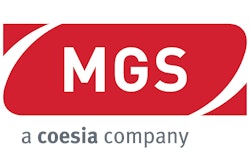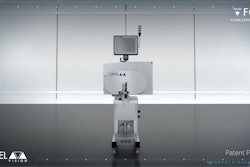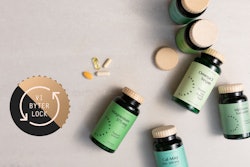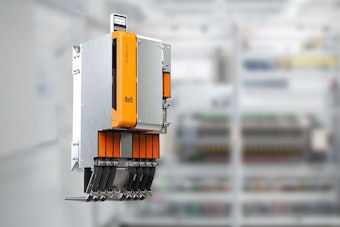OPI Products, Inc., North Hollywood, CA, is one of the world’s leading suppliers of manicure and pedicure products for professional nail care. Best known for its nail lacquer lines, the company has earned a reputation for high-quality, chip-resistant formulas and fashion-forward colors with engaging, flirtatious names.
In addition to its 200+ permanent nail-color offerings, OPI also produces two 12-product seasonal collections each year. A sampling of 2008’s geographically inspired hues—the India Collection by OPI and la Collection de France—provides a good example of the company’s branding wit. The France collection’s color names include such memorable monikers as We’ll Always Have Paris, Tickle My France-Y, and Baguette Me Not.
OPI’s nail lacquer offerings also include 11 clear nail treatment and finishing products, as well as two retail color lines, Nicole by OPI and the just-launched Sephora by OPI, in 48 colors.
To meet the ever-growing, worldwide demand for its products, OPI fills one-quarter million 0.5-oz bottles of nail lacquer per day at its North Hollywood plant, on three custom packaging lines. Discussed here are two of those lines, both of which feature specially engineered versions of Capmatic, Inc.’s (www.capmatic.com) monobloc filling, plugging, and capping machines.
Also on each line, cartoning equipment deftly meets the filling equipment’s high speeds, as well as accommodates unique cartoning configurations. One line incorporates a new Stealth™ cartoner from MGS Machine Corp. (www.mgsmachine.com) that places trayed product in a petite, gabletop carton; the other uses a 35-bottle/min ADCO Mfg. (www.adcomfg.com) cartoner to produce a six-unit carton of colored polish.
Bottles get special treatment
OPI’s most recently acquired lacquer-filling line leads off with Capmatic’s Intrepid™ FBPC, a monobloc filler, ball inserter, plug inserter, and capper, installed in January 2007. Explosion-proof, the filling portion of the line is housed in a Class 100 cleanroom with two other 0.5-oz lacquer fillers and is used primarily to package OPI’s premium nail treatment and finishing products at up to 100 bottles/min.
As are all of OPI’s 0.5-oz nail lacquers, clear treatments are packaged in a patented, brand-recognizable glass bottle decorated and supplied by Vitro Packaging (www.vitropackaging.com). Custom polypropylene caps with the OPI logo embossed on the top, supplied by Berry Plastics (www.berryplastics.com) and JSN Cosmetic Packaging (www.jsn.com), and OPI’s patent-pending ProWide brush are also standard components for its nail-lacquer products.
Unlike other lacquer products though, premium treatments get secondary packaging: a glossy, gabletop carton with a windowed front panel, supplied by Marfred Industries (www.marfred.com). Within the carton, the bottle is held in a thermoform tray, under which rests a folded product leaflet.
For six months after installation of the Intrepid, OPI employees hand-packed both trays and cartons—a slow and laborious process that involved multiple handling steps. A temporary solution involved a standalone, semi-automatic cartoner. Then, in October 2007, OPI completely automated the process with the addition of an MGS Stealth horizontal continuous-motion cartoner fed by a custom bottle-orienting and tray-packing station, also designed and engineered by MGS.
According to OPI vice president of operations Randy Allen, one of the biggest challenges to automating bottle orienting and cartoning was OPI’s limited floor space. “We didn’t have any room, and we weren’t going to tear a wall down,” he says. “Because of the orientation center, we had to shorten everything up and keep a very small footprint.”
The Stealth cartoner measures 17.5 ft from the infeed to the exit of the machine. Immediately following carton discharge, a custom conveyor designed by OPI turns the cartons 90 deg, after which they are laser-coded and packed off within 6 in. of space. “It’s cramped, but we do it,” says Allen. “And we make real good money doing it, too!”
Big automation in a small footprint
Capmatic’s fillers are a favorite at OPI: Five of the machines are used throughout the plant for various manicure and pedicure applications (see related article at packworld.com/casestudy-26092). Explains Allen, the simplicity, dependability, and efficiency of Capmatic’s machines, as well as their ability to be changed over quickly, make them ideal for OPI’s needs.
Over the years, OPI has worked with Capmatic to design a vacuum manifold filling system that uses a set of eight, nine, or 12 filling heads that can be quickly removed and replaced by another set. This results in a full-line changeover, including a change in labels, of less than 5 min.
“Time is money, that’s how important changeover is,” says Allen. “We need to keep production up when we are running at full speed or average speed. We need to produce in excess of 200,000 bottles per day. At 80 bottles a minute [the FBPC’s top-rated speed], five minutes doesn’t sound like much, but 30 minutes can equate to a lot of bottles, especially on our high-speed line [180 bpm].”
Always looking for that little bit of extra speed, OPI runs the FBPC at 100 bottles/min, Allen relates. On the day of Packaging World’s visit, the company was using an eight-head vacuum manifold to fill its Start to Finish Base Coat, Top Coat & Nail Strengthener product.
During operation of the line, after bottles are filled, they are carried into a feedscrew that transfers them to the monobloc’s starwheel. Here, they are indexed two at a time through three stations: brush insertion, cap application and pretorque, and cap torquing. Sensors integrated within the monobloc check for the presence of ball bearings (inserted before filling) and brush placement.
After exiting the monobloc, rejects are pushed offline. Bottles that pass inspection are carried out of the filling room via conveyor through an opening in the wall to a second room, where capped bottles mean explosion is no longer a danger. Here, an OPI-designed labeler adds a batch code to preprinted, pressure-sensitive labels and applies the labels to the bottom of the bottles. Next, a transfer/packoff table gives OPI the flexibility to either remove finished product for packing in trays or automatically pack it in the gabletop cartons using the Stealth cartoner.
For the latter operation, bottles first convey through the orientation station mentioned earlier. Entering the station into a starwheel, bottles are illuminated with a red light from a Cognex (www.cognex.com) vision sensor that detects a printed eyemark. The system then rotates the bottles up to 359 deg, so that the front “panel” of the bottle will be visible when inserted into the carton. Using pneumatics and vacuum, the system then picks and places each bottle into a thermoform, as these plastic inserts, with folded leaflets beneath, move past on a bucket conveyor.
Entering the Stealth cartoner, the thermoforms, along with bottles and leaflets, are horizontally loaded through the bottom of the gabletop cartons by way of a barrel-cam loading device. While the bottom panels of the cartons are tuck-closed, the gabletop is glued and pinched closed. The entire cartoning process is servo motion-controlled with an Allen-Bradley ControlLogix system from Rockwell Automation (www.ab.com). The machine has a top-rated speed of 400 cartons/min, so it easily keeps up with the 100-bottle/min filling line.
After being discharged from the cartoner and sharply conveyed into a 90-deg turn, the cartons move past a Domino(www.domino-printing.com) S100 scribing laser, which applies a batch code to the bottom panel of the carton. This code is used to track product diversion, a problem that Allen says is enormous in the cosmetics industry. “We spend a lot of time and energy on diversion tracking,” he says. “We don’t care about the money we invest in this. Our diverted product kills our main salon owner who uses our product everyday.” The last stop on the line is manual case-packing of the cartons.
Filling color at 180 bottles/min
A second explosion-proof filler stands adjacent to the Intrepid and handles 0.5-oz bottles of colored nail polish. While set up in much the same way as the Intrepid, this line uses a dual filler that can accommodate up to 24 heads, along with a Capmatic Road Runner™ M Series automatic monobloc plugger and capper, for a line speed of 180 bottles/min.
According to Allen, the Road Runner’s high speed sometimes comes at the cost of dependability. “With the Road Runner, if we crash a bottle on the line, we’re shut down for 30 minutes. If we crash a bottle on the Intrepid, we are shut down for five. We don’t crash a lot of bottles, but they do break sometimes, and they are full of paint. And it goes everywhere. Because of the way high-speed lines are engineered, it takes a lot of time to tear the Road Runner down and make sure all the paint is out before we can start the machine up again. So we give up speed for dependability at times,” he says.
When in operation, the line uses two 12-unit vacuum manifold filling heads—the same removable, interchangeable design as used on the Intrepid—for super-fast, 5-min changeovers. After filling, bottles are channeled into one lane, enter a feedscrew, and are transferred to the starwheel of the monobloc. The continuous-motion, rotary monobloc features a 12-head brush inserter and a 12-head capper.
Brushes are oriented with a vibratory bowl that feeds them to an air-infeed track leading to the monobloc’s brush inserter. Caps are sorted with a rotary unscrambler before being placed onto a 4-ft infeed conveyor leading to the capper. “We need a long backup of sorted, uprighted caps to keep up with the speed of the machine,” explains Allen. The caps are fed into the capper, where they are applied by vacuum and torque.
After filling and capping, bottles are conveyed next door for label application and cartoning. At the time of PW’s visit, OPI was applying a preprinted polyvinyl chloride shrink label to the bottle caps, using an applicator and heat tunnel from Marburg Industries (www.marburgind.com). The label was being used to advertise OPI’s patent-pending ProWide brush. Since then, OPI has discontinued this label, but Allen says the equipment will still be used for special promotions.
Next, bottles receive the bottom-applied preprinted label with batch code—the equipment comprising a label applicator from Videojet (www.videojet.com) and a Domino ink-jet printer. Here also, a Keyence (www.keyence.com) vision system inspects the placement of the labels immediately following their application.
For its color products, OPI uses a six-unit, paperboard shipping carton. To load the cartons and keep up with line’s high speed, OPI worked with ADCO Mfg. to design a custom vertical top-load cartoner, the model 6VTC-35. The machine operates at 35 cartons/min, lifting six bottles at a time and loading them into cartons using an OPI-designed/ADCO-built vacuum system.
After exiting the cartoner, the cartons receive a laser code for diversion tracking. Then, an ink-jet printer applies the batch code, UPC code, and item number and name on two panels. The last stop is manual packoff into trays.
Interchangeability is key
On both packaging lines, Allen says the key to cranking out the color at OPI is the dependability and interchangeability of its packaging equipment. “We want to have interchangeability so that our spare parts locker is smaller,” he says. “So if we have a sensor on a machine, we know we’ve got another in stock because all four of our machines use the same sensor in the same place. We have much less downtime this way.”
A tribute to the Intrepid line’s flexibility, last month OPI introduced its Sephora by OPI retail line, with a test-launch conducted in 500 stores. The total cost to change over the line for this brand-new application was just $7,000. “Pretty good, eh?” says Allen.
With equipment like this, one color OPI is sure to see more of is green.






















